

This
sector of the website contains information, publications and
illustrations concerning the ancient history of the related games of colf
(kolf), crosse (choule), golf and mail (pall mall) and the possible
relationship between these European club and ball games.
This sector also includes stick and ball games with an indirect relationship with the European games.
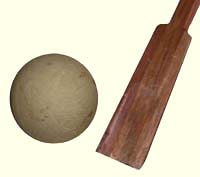
Publication |
Author |
Published (in) |
Jeu de crosse or rather hockey?  |
Sara Kieboom-Nijs |
2025 December |
Our books on the internet  |
Sara Kieboom-Nijs |
2024 September |
Le swin-golf  |
Sara Kieboom-Nijs |
2024 April |
| Boy caddies in colf, mail, crosse and in golf, even young girls  |
Sara Kieboom-Nijs |
2024 March on this site, followed by the publication in Autumn - Golfika no. 34 (Magazine of the European Association of Golf Historians and Collectors) |
| Rather boys than girls in colf, crosse, golf & mail  |
Sara Kieboom-Nijs |
2024 February |
Clearly unsuitable for women  |
Sara Kieboom-Nijs |
2024 January - Revised chapter from 'Games for Kings & Commoners Part One'(2011) |
Delft blue tiles  |
Sara Kieboom-Nijs |
2023 October |
Swingolf  |
Sara Kieboom-Nijs |
2023 August |
Stick and ball playing putti  |
Sara Kieboom-Nijs |
2022 Spring - Golfika no. 29 (Magazine of the European Association of Golf Historians and Collectors) |
| Visit at the Nederlands Golfmuseum, Afferden  |
Mr. Ferd Vrijmoed |
2022 April - Golfkrant N° 49 |
Collecting European clubs & balls  |
Geert & Sara Nijs |
2016 March - Golf Collectors Society Bulletin |
| The first clubhouses in golf & its continental look-alikes  |
Geert Nijs Sara Kieboom-Nijs |
2015 August - Idea & first draft 2022 February - Elaboration |
| The Flemish and the game of 'curling' |
Geert & Sara Nijs |
2015 November - Posting on the blog of a major project of the University of St Andrews Institue of Scottish Historical Research, called 'Scotland and the Flemish people' |
| 'Caveat Emptor' Buyers & sellers beware  |
Geert & Sara Nijs |
2014 December - Through the Green (Magazine of the British Golf Collectors Society) |
| Who needs an ‘Aide’ to play the game  |
Geert & Sara Nijs |
2014 September - Through the Green (Magazine of the British Golf Collectors Society) |
I'd like to teach the world to s(w)ing  |
Geert & Sara Nijs |
2014 June - Through the Green (Magazine of the British Golf Collectors Society) |
Das Mazzaschlagen oder „Alpengolf“  |
Geert & Sara Nijs |
2014 April |
| Golf History for Golf Historians & Collectors  |
Geert & Sara Nijs |
2013 Summer - Golfika no. 12 (Magazine of the European Association of Golf Historians and Collectors) |
| The Italian traditional games of fiolet and rebatta  |
Geert Nijs |
2012 September |
| Did Yuan Dynasty Mongols bring Golf Game Into Europe?  |
Wu Linqi |
2011 September - Golfika no. 8 (Magazine of the European Association of Golf Historians and Collectors) |
Knur and spell & nipsy  |
Gordon Taylor |
2009 February |
Nipsy  |
James Masters |
2009 January |

Geert Nijs, France
The game of fiolet
Since time and age, a
club and ball game called 'fiolet' is played in the Italian region of the 'Valle
d'Aosta', a very mountainous region surrounded by the highest peaks of the Alps
in the extreme north-west of Italy, bordered by France and Switzerland.
In this game, a player hits a ball with a club as far as possible into the
field. A real 'longest drive contest'. The main difference between fiolet and
colf, crosse, golf and mail is that the ball is not hit from the ground but in
the air. The ball does not have to touch a specific target; it is only the
distance that counts.

The fiolet (ball) used
to be a pebble stone with one flat side. Today, the boxwood fiolet is covered
with nails to achieve a weight of 35-40 grams. The ball has an oval form on one
side; the other side is flat. Nowadays, also aluminium fiolets appear in the
field.
The eima or mas(s)ette) or maciocca (club) is 40 to 70 centimetres long. At one
end, the club is somewhat thicker or equipped with a square or cylindrical or
half-cylindrical bulge.
The pira (tee) is a smooth stone placed on a piece of cement of approximately
25 centimetres.
The playing field is a triangular stretch of grass between 150 and 200 metres.
From the tee, the field is divided into stretches of 15 metres.

Two
teams of one or several players play against each other. In turn, they try to
hit the ball into the field. They place the ball with the flat part upon the
pira. With the thick end of the club, they give a smart rap on the end of the
ball. The ball then spins upward, and the player tries to hit the airborne ball
as far as possible into the field, holding his club with one hand. Depending on
the 15-metre stretch where the ball comes down, the player receives points,
with more points awarded for longer hits. The further he hits the ball, the
more points he receives. When all players have had their ten or, depending on
the kind of tournament, more attempts, all points of the individual players or
the teams are totalled to decide which player or team is the winner.
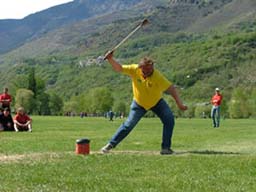
It is of
utmost importance to rap the ball from the tee into the exact height and
direction to hit it, then with full power into the field. – Photo: www.figest.it
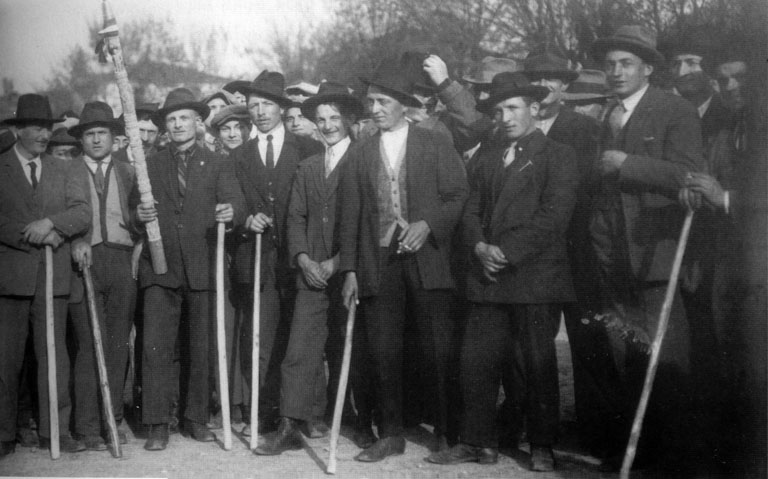
On 17th
July 1924, the 'Federaxon Esports de Nohtra Tera' was founded, the first
association for several traditional games, being part of the nationwide 'Federazione
Giochie e Sport Traditionale'. Today, the final of the championship takes place in
Brissogne on 1st May. The winner receives the 'Baton d'Or. The game
is played during spring after the snow has melted and before the weeds start to
grow and the cattle enter the meadows again. A certain Mr Germano Cheillon
d'Allein, born in 1873, explained: "I played fiolet already during the
last years of the previous (19th century, not only with my friends
but also with much older players."
The game of ‘la
rebatta’
A
similar game, 'la rebatta', is played in the same region of the Valley
of Aosta, but in different communities. Also in this game, players hit
an airborne ball with a club as far as possible into the field. They
play with a rebatta (boxwood ball) with a diameter of 28 to 30
millimetres, weighing 25 to 40 grams. The ball is covered with iron or
copper nails and painted white to make it easier to retrieve in the
field. Nowadays, the players also use aluminium balls with some dimples.
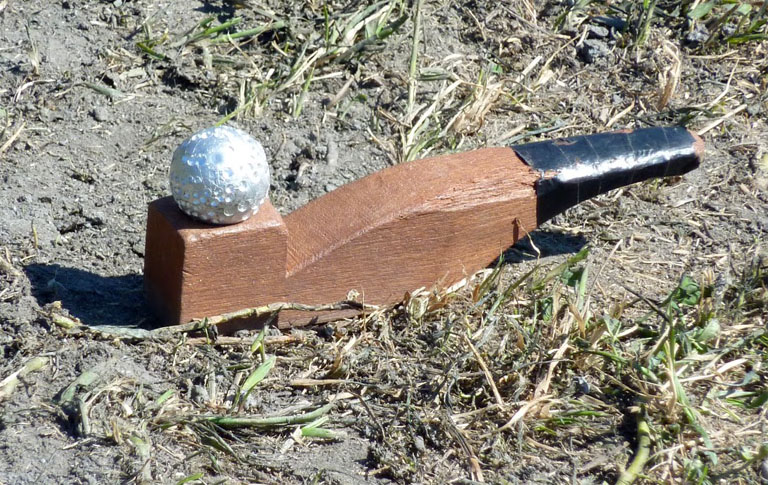
The
wooden lever has the shape of a pipe. The bowl of the pipa or fioletta
(pipe) has a slight hollow to place the rebatta. When the player hits
the stem of the pipe, the ball will jump up to be shot as far as
possible into the field. The club is 100 to 140 centimetres long, made
of ash wood and has a cylindrical part at one end, the matchocca or
masseta.

The player holds the
baton with both hands in a reversed baseball grip. It is interesting to see
that the left arm is straight and the other bent arm is not 'flying' but held
close to the body. It looks like a rather flat golf swing. The playing field is
a triangular stretch of grass up to 250 meters long and approximately 60 meters
wide at the end. This field is divided into stretches of 15 meters. Each
stretch stands for a certain number of points. The farther you hit the rebatta,
the more points you earn. In a tournament, each team has five players. Every
player has twenty attempts, the so-called batua or tsachà. At the end of the
tournament, the points of the teams are added up to decide which team is the
winner.

The tournaments, both
team and individual contests, are held during spring when the snow has melted
and before the cattle take over the meadows. And again in autumn, when the cows
have returned to their sheds. This sport has approximately 400 players divided
into fourteen sports clubs. Like the fiolet players, these clubs are members of
the 'Federaxon Esport de Nohtra Tera'.
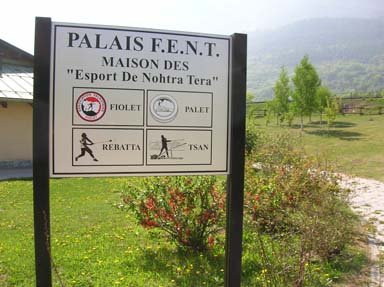
If you would like to
see how fiolet is played or rebatta, have a look at
YouTube.
Information derived from:
- http://www.deepfun.com/fun/2012/08/tocati-2012/ : Giardini Cesare Lombroso
September 2012
Knur and spell & nipsy
Gordon Taylor, England
As a
young boy, some seventy years ago, growing up in Yorkshire, there were two
games of which I was vaguely familiar, which you will have come across in your
research. They were both played in the coal mining area where I was
living.
The first was known as knur and spell and played by the more prosperous people
who could afford the equipment. It consisted of a spring-loaded device which,
when released, threw a small round object into the air to strike with a stick.
From memory, distance seemed to be the main object, but what the rules were, I
am not familiar.
The second was a poorer version of knur and spell, known locally as nipsy and
sometimes shinty. The players played the game without the expensive launcher
but used a small, hard piece of shaped wood with one end shaped into a rough
point. The player tapped the pointed end, which caused the mouse, as it was
called, to flip up in the air from where it was, then struck it with a stout
stick.
Any spare bit of ground was sufficient to play both games and they did not need
special playing areas. They were known as poor man's golf, and they helped to
pass on a few hours and make life and times a little more interesting.
February 2009
Nipsy
James Masters, England –
www.tradgames.or.uk/games/knur-spell.htm
The picture in the 'Afterword' of
CHOULE - The Non-Royal but most Ancient
Game of Crosse, representing a group of players with special bats
around a small seesaw, shows people playing a game called 'nipsy'. This game
was popular, especially in southern Yorkshire in England. In the areas
around Bolton and Barnsley in Lancashire, people still play variants of the
game.

The picture shows how the
'trippet' or 'spell' worked and how the distance was measured by pushing sticks
into the ground at regular intervals. – George Walker, c. 1817
The
game is a kind of 'longest
drive'. The player places the ball on one side of a small seesaw and
hits it on
the other side. The ball will jump up, and the player hits the ball
with his bat as far as possible into the field. The little stake is one
of a series for
measuring the distance achieved. Good players can hit the ball as far
as 200
meters. The shape and size of the bat and the rules of the game vary
from
region to region, as do the little seesaws.
In the Picardie region in
northwest France, a variant of the game was popular in days long gone, under
the name of 'jeu de la tapette'.

Jeu de la tapette, a popular
game in Picardie in the long-gone past. – Anonymous

